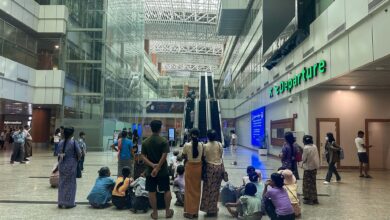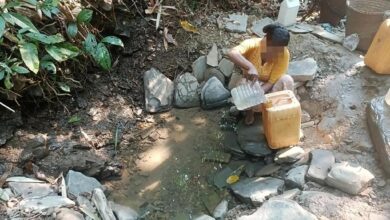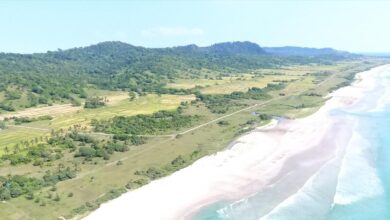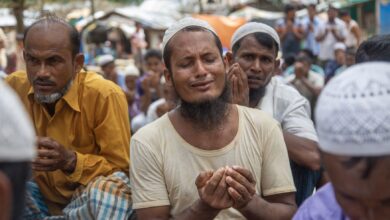
Over the past week, residents of the Karenni (Kayah) State capital of Loikaw have begun greeting one another differently.
“Why haven’t you left?” has replaced “good morning,” accompanied by hushed exchanges about the fighting occurring through each of the previous nights.
By Tuesday, half of the town’s 50,000 residents had fled, driven out by a relentless military campaign of shellings, airstrikes and gunfire, the likes of which have already displaced 150,000 people throughout Karenni State.
Fifty-five-year-old Loikaw resident Maung Maung* held out as long as he could, reluctant to leave the town where he had lived since birth.
“It is easier to tell people to flee than to actually flee,” he said. “We have to decide which belongings to take with us and find a vehicle to travel in. There is a lot of trouble. Buses have also stopped operating.”
On Tuesday night, as he heard guns and artillery being fired for the third time in a week, he told his two teenage daughters to pack their belongings from the family’s home in central Loikaw’s Zay Paing ward.
When morning came, three generations of the family fled together.
Maung Maung said his 85-year-old mother was surprisingly stoic as she left behind a lifetime of possessions. What remains will remain here, she told him.
“This is my first ever experience of war in my over fifty years of living,” Maung Maung, an ethnic Intha man who spent his career working as a driver, told Myanmar Now.
“‘War’ and ‘displacement’ used to be terms I only read in books or saw in movies,” he explained, adding that he had visited parts of Karenni State that had been the sites of military abuses in Myanmar’s decades-long civil war, but that he had never before witnessed the violence firsthand.
“I had never known what war really was, to be honest.”
Resistance strongholds threaten junta claim to power
The deterioration of security for locals in Loikaw correlates with the intensification of clashes between local armed resistance groups and the Myanmar military, which seized power from the elected civilian government in a February 1 coup last year.
In the more than 11 months that have passed, the junta has killed nearly 1,500 civilians nationwide, according to conservative estimates.

Loikaw, as well as Demoso 20 km to the south, have both subsequently grown into anti-junta strongholds, despite heavy military occupation. The capital township is the site of several Myanmar army bases: Loikaw Regional Operation Command, Infantry Battalion 54, Light Infantry Battalions 250 and 261, and Artillery Battalion 356.
Located less than five hours’ drive east of the junta capital of Naypyitaw, the resistance movement in these Karenni State townships is seen as a physical threat uncomfortably close in proximity to the coup regime’s administrative centre.
The Karenni Nationalities Defence Force (KNDF), a leading 18-battalion resistance group in the state, was formed in late May by local opponents of the regime and youth who fled urban areas to take up arms against the military. While its spokesperson has refused to reveal figures concerning the KNDF’s total membership, it is estimated to be in the low thousands.
However, such anti-coup forces have struggled to equip their members with sufficient weapons and ammunition to face off against the Myanmar army, instead relying on local knowledge of the geographic terrain and guerrilla tactics to ambush junta troops.
One of the first clashes between the junta’s forces and the Karenni resistance was reported on May 21, when Karenni armed groups seized three military outposts in Demoso and Bawlakhe townships. The attack was in retaliation for the Myanmar army entering Demoso town the day before and opening fire on residential areas, an attempt to coerce locals into submitting to military rule.
Two days later, the resistance fighters overran a local police outpost in Moebye, in southern Shan State’s Pekhon Township, which also borders Karenni State. At least 20 of the junta’s forces were killed and four police officers taken into the local forces’ custody.
The seizure of Moebye police station was one of the first large-scale attacks carried out by the armed resistance on a site belonging to the junta’s armed forces, signaling the start of a new front in Karenni State against the coup regime.
The KNDF has claimed that local forces such as theirs have killed some 250 junta soldiers in more than 130 clashes in the second half of 2021.
In retaliation, the Myanmar army has launched offensives from the ground and the air in Loikaw in an attempt to annihilate the Karenni resistance, closing in on residential wards including Maing Lone, Pan Kan, and Ywar Tan Shay, from which most locals have fled.
The shift has signified a spread of clashes from remote areas—like those occurring in Sagaing and Magway regions and Chin State—to the streets of major towns. In northwestern Myanmar, the military has been using the same tactics now being employed in Loikaw to crush the armed resistance and supporters of the shadow National Unity Government’s People’s Defence Forces (PDFs).
In addition to attacks from the air, the junta’s ground forces terrorised villages by burning homes and torturing civilians, often to death, after using them as human shields. On Christmas Eve in Karenni State, the military massacred more than 30 civilians near Moso village in Hpruso Township, setting fire to their bodies in what is believed to be an attempt to destroy evidence of the crime.
In other cities such as Yangon and Mandalay, sporadic attacks by the resistance against Myanmar army soldiers, police and junta-appointed local administrators by urban guerrilla fighters are still reported on a near-daily basis.
The military council’s forces have also clashed with several ethnic armed organisations in Kachin, Karen and northern Shan states, with thousands of soldiers reported to have been killed since February last year.
Clashes in the state capital intensify
The most recent episode of fighting erupted on the morning of January 6 at a Loikaw intersection, when members of a resistance coalition typically described in junta-run newspapers as “terrorists” ambushed occupying junta troops. The groups included the KNDF, Karenni Army (KA), Karenni Democratic Front (KDF) and the local PDF chapter.
The KNDF accused the military of attempting an assault on territory controlled by the Karenni force’s second battalion.
At least 15 junta troops were killed during the 30-minute firefight while the resistance suffered no casualties, according to the KNDF. The group said it seized several weapons after the fighting had ended.


Hours later resistance forces attacked Myanmar army troops who were preparing to launch their own ambush in the southern Maing Lone ward, in front of Loikaw Technological University.
Citing a civilian source, a member of the Loikaw-based KDF told Myanmar Now that the military carried its dead soldiers away from the scene in dump trucks. By midday, they retaliated by firing shells into the ward, reportedly injuring two civilians including a blind man who was hit in the back by shrapnel.
A witness said that the man sustained a three-inch wound and was in a critical condition at Loikaw General Hospital.
Myanmar Now was unable to independently verify the resistance groups’ claims, nor has the organisation been able to reach military spokespersons for comment on the recent fighting in Loikaw.
Three tanks were seen by an eyewitness leaving the Regional Operation Command base in Minsu ward in central Loikaw at around noon, presumably to send reinforcements to troops in Demoso, where clashes had broken out in response to military offensives in the area.
The subsequent battles in Demoso lasted for more than seven hours near Daw Poe Si, 5-Mile and 6-Mile villages. The KNDF claimed at least eight junta soldiers were killed, and they also accused the military of torching four homes in 6-Mile village.
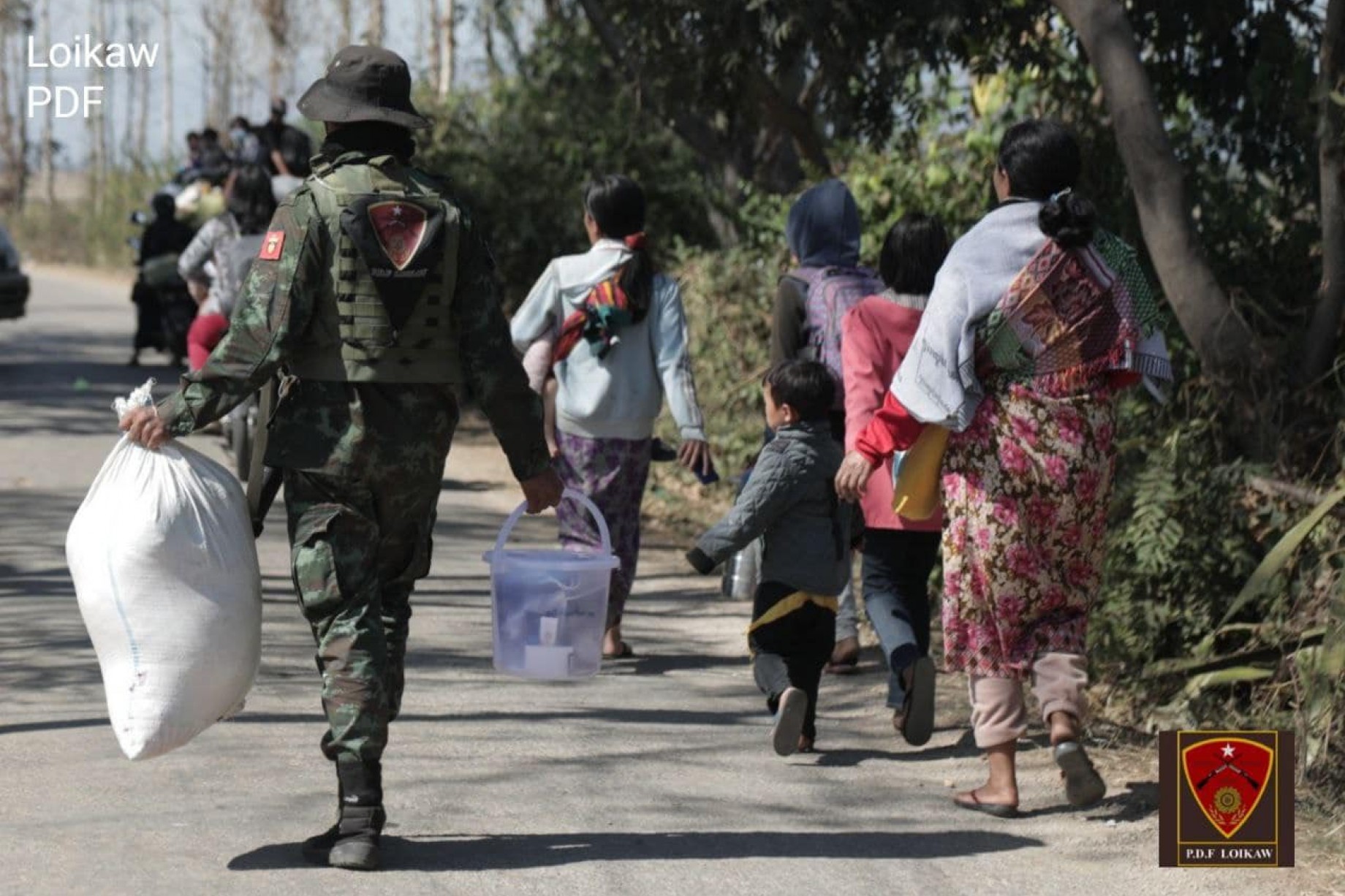

Clashes continued to escalate on January 7 in Loikaw’s Maing Lone and Pan Kan wards, with many residents trapped in their homes. At least six civilians were killed by the junta’s indiscriminate shooting in the town, according to the KNDF, which said that one of their members and one from the KDF were also killed.
That day, the KNDF urged residents to flee Loikaw for safer areas and offered assistance in doing so, declaring that “urban warfare” had overtaken the Karenni State capital.
Maing Lone resident Ko Nge* sent his family north to Shan State at this point, but remained in Loikaw himself, relocating to another ward not directly under fire.
“We feel a bit down as almost everyone in the town has left,” he told Myanmar Now on Wednesday. “We can’t really say the military won’t just do whatever they want to our town,” Ko Nge added, a reference to junta forces looting empty homes—which he said had already begun.
On January 6, the same day that fighting broke out in the city, junta authorities cut off access to electricity in several of Loikaw’s wards, including Maing Lone. Three days later, the entire township was without power, and subsequently, without a water supply or stable internet access.
The deployment of one helicopter and two fighter jets to assault the resistance from the air began in Loikaw on January 8. It culminated in 10 airstrikes in five hours, according to the KNDF, which speculated that that the move was an attempt to reinforce ground troops losing battles earlier in the day in Maing Lone and Pan Kan.
Some 30 soldiers were killed and a tank destroyed by the allied resistance forces in those battles, the KNDF reported.
A member of the Loikaw PDF named Ree Reh Tun Kyi was also killed while attempting to rescue elderly locals trapped in their homes, the group said.
Loikaw resident Maung Maung, who would not flee for four more days, said that even in Zay Paing ward, six miles from the areas directly under attack, the atmosphere was tense.
“I can only imagine what it was like for those who live there [in the targeted wards]. Our hearts were pounding, even from the sound [of shelling and gunfire],” he said. “Those are not the sounds that people should be hearing in their daily lives, especially young kids.”
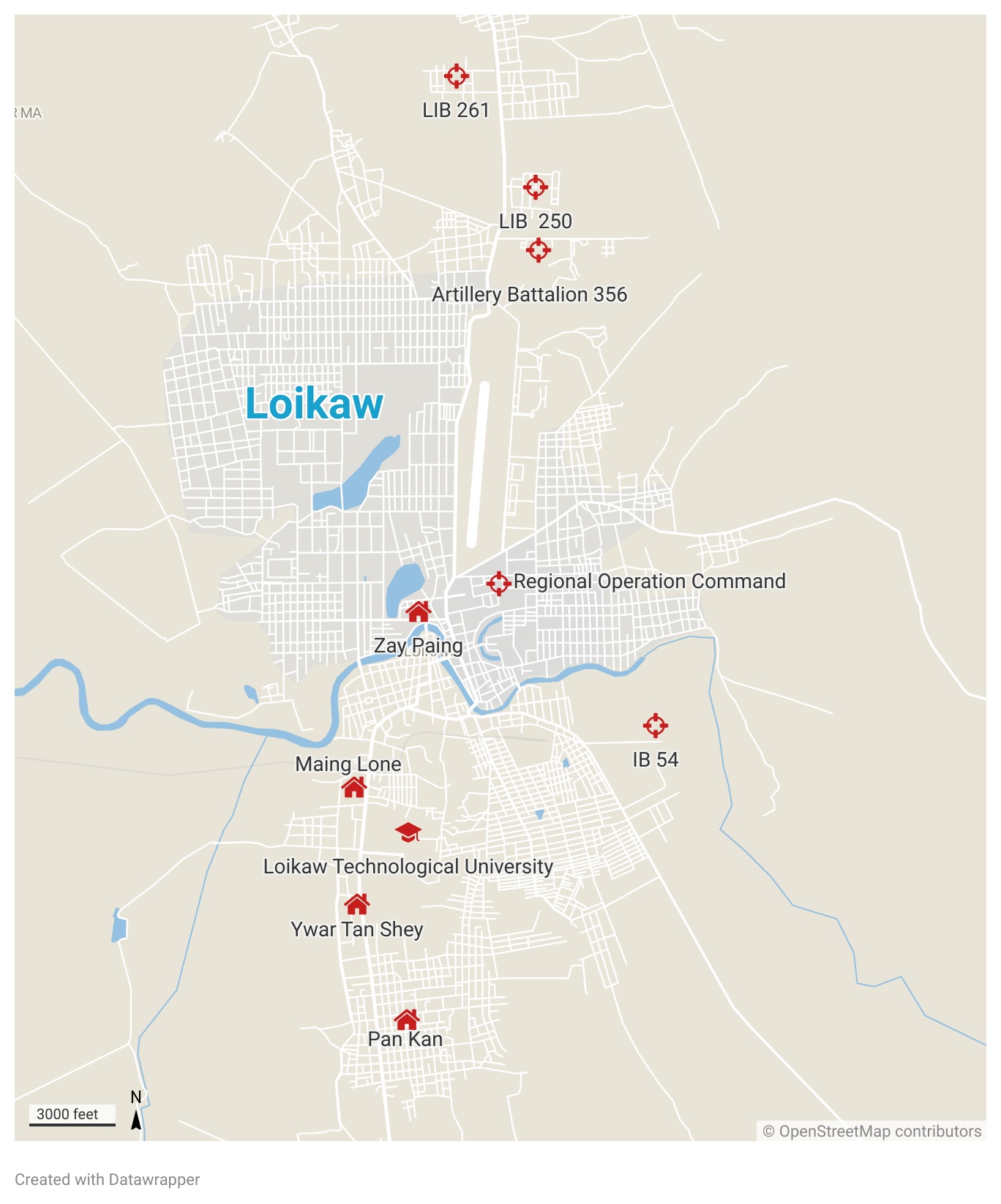

‘The whole country’s cause’
As the junta launched its first airstrikes on Loikaw, the Karenni National Progressive Party (KNPP) called on international governments and organisations to take immediate action against the Myanmar military.
As the political wing of the KA—founded in 1957 to fight for greater Karenni self-determination—the KNPP also asked the international community to provide humanitarian assistance and protection for civilians caught in the ongoing fighting.
“It is like they want to show us that ‘we can kill you whenever we want and your lives are in our hands,’” KNPP secretary Aung San Myint told Myanmar Now, describing the assault on Karenni State as “the whole country’s cause.”
“If we can’t stop the military’s actions now at this time, it will spread to the whole country,” Aung San Myint said.
Clashes continued to break out between the KNDF and the junta over the next two days, particularly in Maing Lone and Pan Kan, with the Karenni forces reporting weapons seizures from the Myanmar army.
Further airstrikes were likely to be carried out, they warned locals.

On January 11, the wards were reportedly hit nine times by bombs dropped from military aircraft.
In a statement that day, the KNDF accused the “terrorist military council” of committing war crimes, including the targeting of civilians and civilian buildings, as well as the burning of homes.
Claiming to have killed 20 junta soldiers that day but only losing one of their own, the coalition forces belonging to the KA, KNDF and PDF said in the statement that they were attempting to “wipe out” the junta columns perpetrating crimes against civilians in Loikaw.
Junta-controlled media accused the “terrorist” resistance forces of occupying civilian and religious buildings and using locals as “human shields,” a practice of which the military itself has repeatedly been accused by communities in warzones across Myanmar.
Gunshots and artillery fire were heard downtown two days later for a 12-hour period beginning at 3am near Thiri Mingalar market. Military shells hit the town’s water purification centre and two neighbouring monasteries—Shwe Taung and Shwe Kyaung—according to an eyewitness. Internally displaced persons who had been sheltering in one of the monasteries had to flee once again.
KNPP secretary Aung San Myint emphasised the need for a “safe humanitarian zone” for displaced locals as places of refuge grow increasingly rare.
His fear is that Karenni State “will eventually be burned to ashes.”


The last residents
Daw Soe*, a vegetable seller who lives in Daw Au Khu ward just one mile from the site of one of Tuesday’s major shootouts, was—along with her adult daughters, son-in-law and grandchildren—among the last residents still in Loikaw at the time of reporting. She told Myanmar Now on Wednesday that she would remain in the town to protect her home until she considered it untenable to do so.
“I am worried that my belongings will be looted. As I am a widow, I can’t afford to buy another motorbike during this difficult time,” she said. “We have dug a bunker. If we still get hit, then it is our fate that we shall die. I don’t plan to go anywhere else for now.”
Her main concerns were financial, she explained, pointing out that if she fled Loikaw, she would have no way to support herself or to replace what she would stand to lose, describing departure as “a last resort.”
“It is not like we won’t leave no matter what. We are still waiting to see what happens,” Daw Soe said.
The same day that Daw Soe spoke to Myanmar Now about her decision to remain in Loikaw, another resident, Maung Maung, finally left his two-storey house in the town for Nyaung Shwe (Yawnghwe) in Shan State, some 130 km away. There, he, his mother, wife and daughters plan to stay with a relative in the large Intha community, to which he also belongs.
No matter how long the war lasts, he vowed that one day he would return to his hometown in Karenni State.
“There are no longer people in Loikaw to greet you with, ‘haven’t you left yet?’ because nearly all of them have already fled.”
*The names of the sources in this article have been changed for their personal security.
